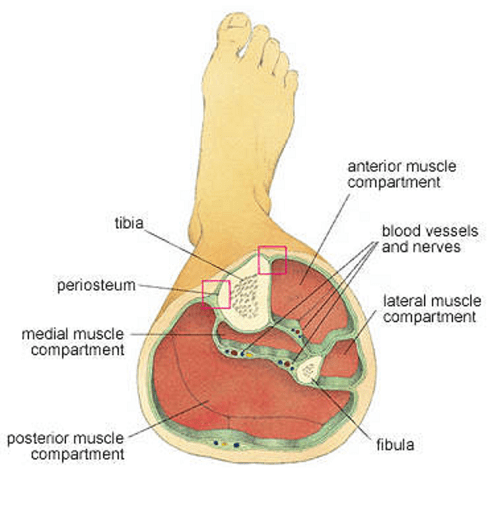Compartment Syndrome: Common Causes, Symptoms & Treatment Options. Do You Have A Question? Speak To A Therapist Today. Call (24/7): 1300-003-777.
Anatomy Of The Lower Leg Region
Compartments are groupings of muscles, nerves, and blood vessels in your arms and legs. Surrounding these tissues is a fibrous membrane called the fascia. Fascia is responsible for keeping the tissues in place and therefore the fascia is relatively inflexible. Compartment syndrome occurs in the anterior (front) compartment of the lower leg. It can also occur in other compartments in the leg, as well as in the arms, hands, feet, and buttocks. Given the inflexible nature of fascia, pressure may build up within the respective compartments and prevent blood flow to tissues. Severe tissue damage can result with loss of body function or even death. Majority of cases that we encounter in practice demonstrate pain, general dysfunction and swelling of the affected limb.
Causes & Symptoms Of Compartmental Pain
- Acute compartment syndrome
- Is the most common type of compartment syndrome. It’s estimated that 75% of cases are because of bone fracture.
- Other causes include crush injuries, burns, excessively tight limb bandaging, surgery, blood clots, vigorous exercise & anabolic steroid usage.
- The hallmark sign is pain when the muscle is stretched with possible tingling and burning.
- Muscle weakness or paralysis are considered immediate medical emergency.
- Chronic compartment syndrome
- Typically develops over a period of weeks to months due to excessive physical activity stress.
- Pain typically subsides when activity stops or reduces in intensity.
- Associated symptoms may include transient numbness, reduced limb range of movement & swelling.
Compartment Syndrome Treatment Options
Treatment for compartment syndrome focuses on reducing pressure within the respective compartment.
Relative Rest
Chiropractic & Physiotherapy
Conservative manual therapies are a brilliant option for managing compartment syndrome. Treatment may include:
- Mobilization of the effected limb to assist with reducing pressure and swelling.
- Soft tissue massage to the associated connective tissue structures to assist with pain reduction and swelling.
- Physiological therapeutics such as Ultrasound, Shockwave therapy and low level laser treatment to assist with reducing inflammation and compartment pressure.
Surgical Intervention (Fasciotomy)
If you do not respond to conservative management as expected then surgical intervention may be warranted. A fasciotomy is a common procedure to do this. This procedure involves making an incision into the thick, fibrous fascia surrounding the compartment to allow the muscle and associated soft tissues more room.
Chiropractor Compartment Syndrome Research
- It is thought that hyperbaric oxygen therapy may be useful in the management and therefore resolution of compartment syndrome. Fitzpatrick, D. (1998). Adjunctive treatment of compartment syndrome with hyperbaric oxygen. Military Medicine, 163(8); 577 – 579.
- Surgical intervention was avoided in individuals who were re-trained in gait and running patterns. Diebal, A. (2012). Forefoot running improves pain and disability association with chronic exertional compartment syndrome. The American Journal of Sports Medicine, 40(5)
Additional Information
If you wish to continue your reading about Compartment Syndrome please click here.

